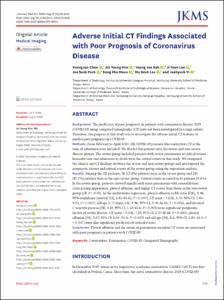KUMEL Repository
1. Journal Papers (연구논문)
1. School of Medicine (의과대학)
Dept. of Internal Medicine (내과학)
Adverse Initial CT Findings Associated with Poor Prognosis of Coronavirus Disease
- Alternative Author(s)
- Jeon, Young June; Kim, Jin Young; Lee, Ji Yeon; Park, Jae Seok; Moon, Sung Min; Lee, Mu Sook; Yi, Jae Hyuck
- Journal Title
- Journal of Korean Medical Science
- ISSN
- 1011-8934
- Issued Date
- 2020
- Keyword
- Coronavirus; Pneumonia; COVID-19; Computed Tomography
- Abstract
- Background:
The predictors of poor prognosis in patients with coronavirus disease 2019 (COVID-19) using computed tomography (CT) have not been investigated in a large cohort. Therefore, the purpose of this study was to investigate the adverse initial CT features to predict poor prognosis in COVID-19.
Methods:
From February to April 2020, 281 COVID-19 patients who underwent CT at the time of admission were included. We divided the patients into the severe and non-severe disease groups. The severe group included patients with severe pneumonia or critical events. Intensive care unit admission or death were the critical events in this study. We compared the clinical and CT findings between the severe and non-severe groups and investigated the prognostic factors and critical events of the severe group using the regression analysis.
Results:
Among the 281 patients, 36 (12.8%) patients were in the severe group and 245 (87.2%) patients were in the non-severe group. Critical events occurred in 10 patients (3.6%). In the severe group, patients showed significantly more pneumonia with consolidation, crazy-paving appearance, pleural effusion, and higher CT scores than those in the non-severe group (all, P < 0.05). In the multivariate regression, pleural effusion (odds ratio [OR], 8.96; 95% confidence interval [CI], 1.81–44.42; P = 0.007), CT score > 5 (OR, 3.70; 95% CI, 1.44–9.53; P = 0.007), old age (> 77 years, OR, 9.96; 95% CI, 3.78–26.28; P < 0.001), and elevated C-reactive protein (OR, 4.15; 95% CI, 1.62–10.6; P = 0.003) were significant prognostic factors of severe disease. CT score > 5 (OR, 7.29; 95% CI, 1.37–38.68; P = 0.020), pleural effusion (OR, 5.67; 95% CI, 1.04–30.8; P = 0.045) and old age (OR, 8.6; 95% CI, 1.80–41.0; P = 0.007) were also significant predictors of critical events.
Conclusion:
Pleural effusion and the extent of pneumonia on initial CT scans are associated with poor prognosis in patients with COVID-19.
- Publisher
- School of Medicine (의과대학)
- Citation
- YoungJun Chon et al. (2020). Adverse Initial CT Findings Associated with Poor Prognosis of Coronavirus Disease. Journal of Korean Medical Science, 35(34), e316. doi: 10.3346/jkms.2020.35.e316
- Type
- Article
- ISSN
- 1011-8934
- Appears in Collections:
- 1. School of Medicine (의과대학) > Dept. of Internal Medicine (내과학)
1. School of Medicine (의과대학) > Dept. of Radiology (영상의학)
- 파일 목록
-
-
Download
 oak-2020-0640.pdf
기타 데이터 / 3.56 MB / Adobe PDF
oak-2020-0640.pdf
기타 데이터 / 3.56 MB / Adobe PDF
-
Items in Repository are protected by copyright, with all rights reserved, unless otherwise indicated.